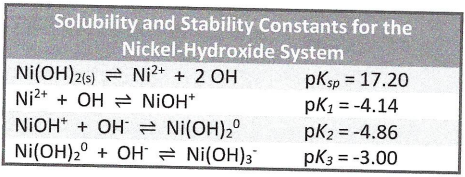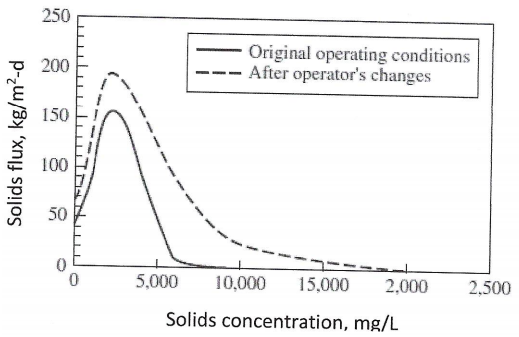Reference no: EM131966068
Assignment -
Question 1 - An experiment conducted at 20 C and 1 atm to determine the rate of oxygen absorption in an agitated tank yielded the data tabulated at right.
a. What is the oxygen mass transfer coefficient for this system? Consult a DO saturation table or use the Henry's Law coefficient to determine the saturation concentration of oxygen in water under the given conditions.
b. If the tank volume is 5 m3, what effluent DO concentration could be attained when aerating clean water at a flow of 0.05 m3/s and influent DO of 2.0 mg/L? Assume that the tank is completely mixed.
c. A well water containing 10 mg/L methane (CH4) is to be treated using the aeration system tested above. Assume that the temperature is 20 C. The mass transfer coefficient of methane may be estimated from the oxygen mass transfer coefficient using the relationship
(KLα)i/(KLα)02 = (Di/D02)0.66
where D is the diffusion coefficient of the gas in water. Air contains about 0.0002% CH4 by volume, and the diffusion coefficients in water are 1.97 x 10-5 cm2/s for O2 and 1.81 x 10-5 cm2/s for CH4. If several of the tanks described in part b are available, how many of these tanks in series are required to reduce the methane concentration to no more than 0.01 mg/L?
|
Batch Aeration Data
|
|
Time, min
|
DO, mg/L
|
|
0
|
0
|
|
5
|
0
|
|
10
|
2.0
|
|
20
|
3.5
|
|
30
|
4.7
|
|
40
|
5.6
|
Question 2 - Nickel, at a concentration of 80 mg/L, is to be removed from a wastewater stream by hydroxide precipitation. Use a log-concentration diagram to determine the minimum attainable dissolved nickel concentration, and the pH at which that minimum occurs. Equilibrium constants listed at right may be used for this purpose.

Question 3 - A process wastewater contains 30 mg/L of phenol, and must be treated so that the phenol concentration in the treated wastewater is 0.5 mg/L. In a batch isotherm test to quantify the commercial PAC product C25P necessary to treat the phenol, the results shown at right were obtained.
|
Batch Isotherm Test Results for Phenol and C25P
|
|
PAC dose g/L
|
Equilibrium Phenol Concentration mg/L
|
|
1
|
23.74
|
|
2
|
20.44
|
|
5
|
8.94
|
|
10
|
1.87
|
|
15
|
0.47
|
|
20
|
0.15
|
a. Determine whether the data is best described by the Fruendlich or the Langmuir isotherm. Determine the parameter values for the isotherm selected.
b. Determine the dose of C25P necessary to reduce the phenol concentration to 0.5 mg/L in a batch adsorption system.
c. A related GAC product C25G has a bulk density of 0.61 g/cm3 and exhibits the same sorption behavior towards phenol as C25P above. Estimate the time to breakthrough if treatment (to 0.5 mg/L phenol) is performed using a GAC column containing C25G. Determine also the number of bed volumes of water treated before breakthrough and the quantity of GAC consumed cubic meter of water treated. The column is to have a depth of 1.5 m, a cross section of 1.0 m2, and a loading rate of 0.20 m/min.
Question 4 - Write the theoretical equation for the reaction of alum with alkalinity.
a. If a water has no natural alkalinity, and commercial quicklime (CaO, 85% purity) must be added to furnish alkalinity to react with the alum, how many kg of quicklime must be added per kg of alum?
b. How much CO2 (mg/L) is produced for each mg/L of alum added?
c. How much AI(OH)3 is produced (mg/L) per mg/L of alum added?
Question 5 -A horizontal flocculator has 2 arms, is 6 m long, and rotates at 5 rpm. On each arm is mounted a single redwood slat 0.3 m wide, with the center of the slat 1 m from the axis. The basin is 7 m x 3 m x 3 m in size.
a. Calculate the value of the velocity gradient G. Assume a water temperature of 4 C, a drag coefficient of 1.5, and that the roll velocity of the water is 20% of the paddle velocity.
b. Calculate the power needed to turn the flocculator.
Question 6 - The sedimentation process in a water treatment plant was operating poorly. Inflow to the clarifier was at a rate of 5,000 m3/d, with a solids content of 1,500 mg/L. While the clarifier could provide the necessary solids flux, the underflow solids concentration was fairly low, only 6,500 mg/L. This resulted in a sludge with a high moisture content, leading to increased sludge disposal costs. Consequently, the plant operators decided to add microsand after coagulation and flocculation, to enhance the settleability and compactability of the sludge. The solids flux curves for the operation, before (solid line) and after (dashed line) the addition of microsand are shown in the figure at right.

a. Determine the maximum solids flux in the clarifier under the original operating condition, i.e. prior to the addition of microsand.
b. What clarifier area would be required under the original operating condition for the solids loading given?
c. What would be the underflow rate under the original operating condition?
d. If, after the addition of microsand, the same solids flux is maintained, what would be the maximum attainable underflow solids concentration?
e. With the addition of microsand, what maximum solids flux could be attained while maintaining an underflow solids concentration of at least 10,000 mg/L? What would be the maximum inflow that could be treated if the influent solids concentration remains 1,500 mg/L?
Question 7 - Specifications for the media in a dual-medium filter with a filtration rate of 150 L/m2-min are tabulated at right.
|
Specification for Filter Media
|
|
Medium
|
Sand
|
Anthracite
|
|
Density, g/cm3
|
2.65
|
1.40
|
|
Porosity
|
0.40
|
0.50
|
|
Depth, mm
|
300
|
500
|
|
Effective diameter, mm
|
0.5
|
1.0
|
|
Uniformity coefficient
|
1.6
|
1.6
|
|
Sphericity
|
0.95
|
0.65
|
a. Which medium should be on the top, and which in the bottom of the filter?
b. What would be the clean-bed head loss through the filter during the filtration cycle?
c. What would be the minimum backwash velocity through the filter?